Strategic Human Resource Management Project: Ingogo Company Analysis
VerifiedAdded on 2022/08/18
|30
|7296
|24
Project
AI Summary
This project offers a comprehensive analysis of strategic human resource management (SHRM) within Ingogo Company, an Australian online taxi booking and payment service. The assignment begins with an overview of the concept map illustrating the misalignment between human resource strategy and organizational strategy, from both senior management and human resource manager perspectives, highlighting factors such as organizational culture, employee job satisfaction, and reward systems. Task 2 delves into SHRM principles, defining it as a process of attracting, developing, motivating, and retaining talent to meet both organizational and individual goals. It identifies two key SHRM problems faced by Ingogo: the need for a learning organization and the importance of employee engagement, particularly considering the company's reliance on drivers. The project then evaluates these areas, referencing literature on learning organizations (Peter Senge's model) and employee engagement strategies. Finally, it provides recommendations for improving these aspects, including suggestions for fostering continuous learning and enhancing employee well-being. Task 3 presents discussion forum posts addressing various SHRM topics. Task 4 provides an introduction, differences between SHRM and vanilla HRM, and selected topic areas like change in approach. The project concludes with a thorough discussion of the challenges and provides recommendations for the future.
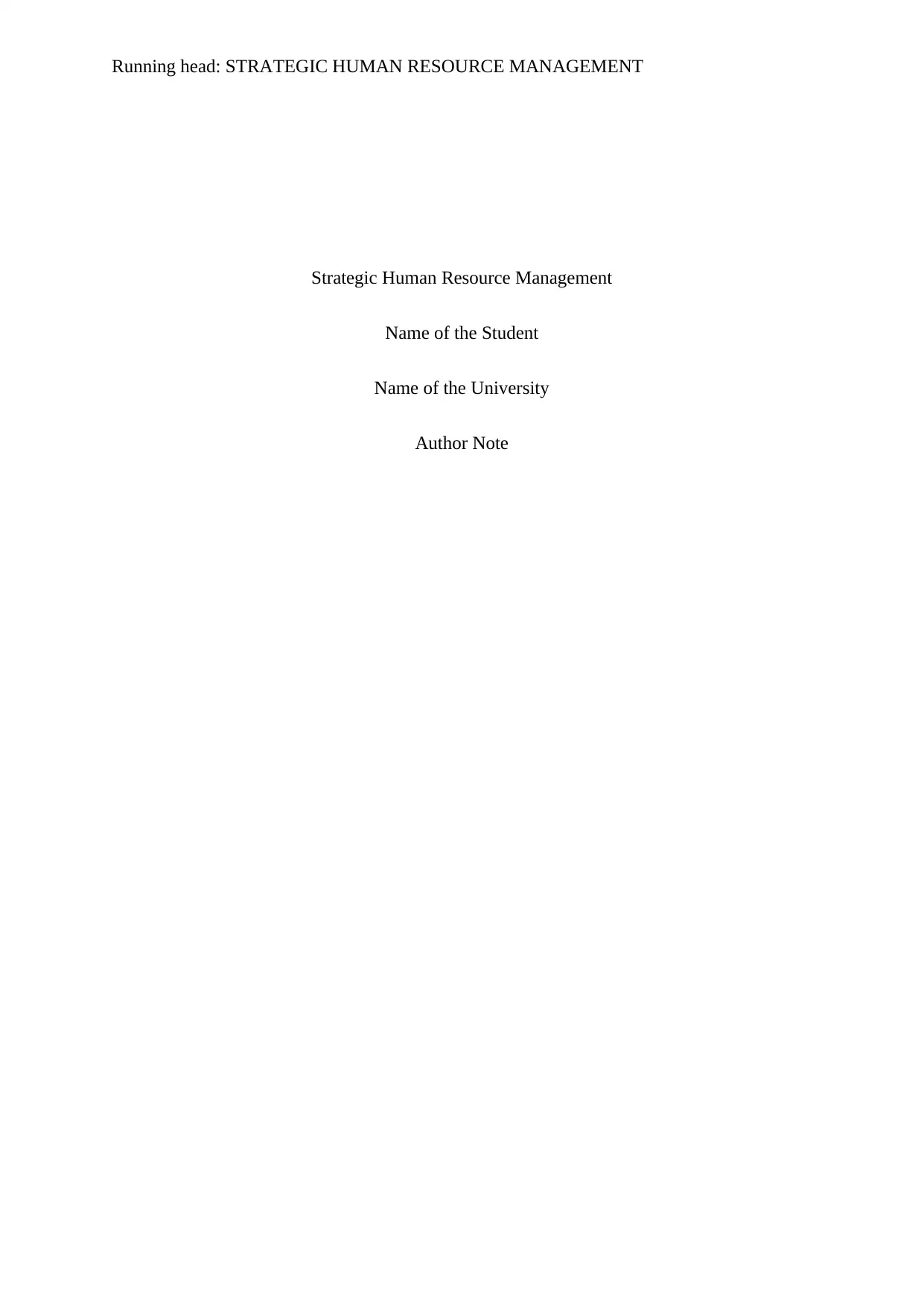
Running head: STRATEGIC HUMAN RESOURCE MANAGEMENT
Strategic Human Resource Management
Name of the Student
Name of the University
Author Note
Strategic Human Resource Management
Name of the Student
Name of the University
Author Note
Paraphrase This Document
Need a fresh take? Get an instant paraphrase of this document with our AI Paraphraser
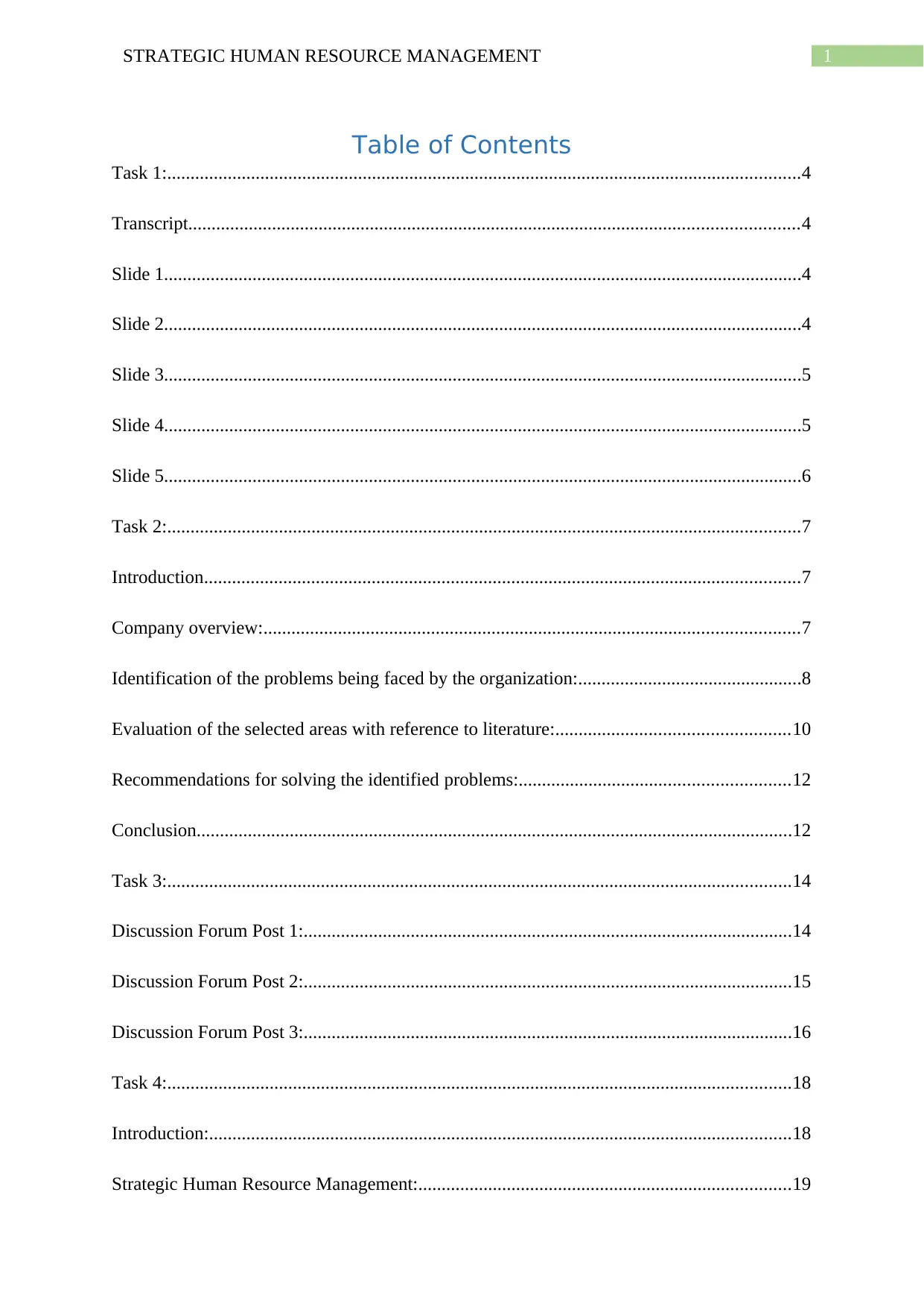
1STRATEGIC HUMAN RESOURCE MANAGEMENT
Table of Contents
Task 1:........................................................................................................................................4
Transcript...................................................................................................................................4
Slide 1.........................................................................................................................................4
Slide 2.........................................................................................................................................4
Slide 3.........................................................................................................................................5
Slide 4.........................................................................................................................................5
Slide 5.........................................................................................................................................6
Task 2:........................................................................................................................................7
Introduction................................................................................................................................7
Company overview:...................................................................................................................7
Identification of the problems being faced by the organization:................................................8
Evaluation of the selected areas with reference to literature:..................................................10
Recommendations for solving the identified problems:..........................................................12
Conclusion................................................................................................................................12
Task 3:......................................................................................................................................14
Discussion Forum Post 1:.........................................................................................................14
Discussion Forum Post 2:.........................................................................................................15
Discussion Forum Post 3:.........................................................................................................16
Task 4:......................................................................................................................................18
Introduction:.............................................................................................................................18
Strategic Human Resource Management:................................................................................19
Table of Contents
Task 1:........................................................................................................................................4
Transcript...................................................................................................................................4
Slide 1.........................................................................................................................................4
Slide 2.........................................................................................................................................4
Slide 3.........................................................................................................................................5
Slide 4.........................................................................................................................................5
Slide 5.........................................................................................................................................6
Task 2:........................................................................................................................................7
Introduction................................................................................................................................7
Company overview:...................................................................................................................7
Identification of the problems being faced by the organization:................................................8
Evaluation of the selected areas with reference to literature:..................................................10
Recommendations for solving the identified problems:..........................................................12
Conclusion................................................................................................................................12
Task 3:......................................................................................................................................14
Discussion Forum Post 1:.........................................................................................................14
Discussion Forum Post 2:.........................................................................................................15
Discussion Forum Post 3:.........................................................................................................16
Task 4:......................................................................................................................................18
Introduction:.............................................................................................................................18
Strategic Human Resource Management:................................................................................19
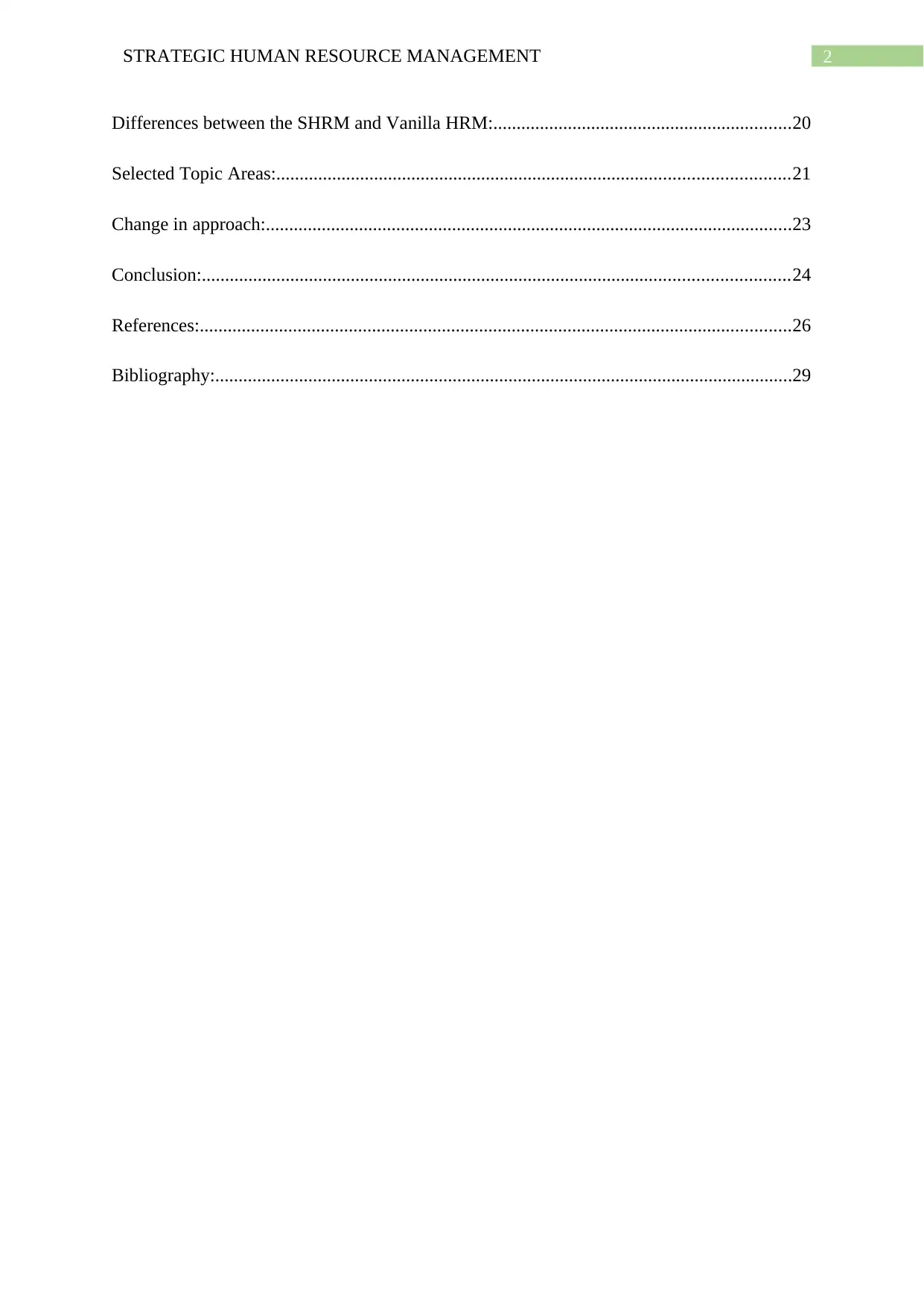
2STRATEGIC HUMAN RESOURCE MANAGEMENT
Differences between the SHRM and Vanilla HRM:................................................................20
Selected Topic Areas:..............................................................................................................21
Change in approach:.................................................................................................................23
Conclusion:..............................................................................................................................24
References:...............................................................................................................................26
Bibliography:............................................................................................................................29
Differences between the SHRM and Vanilla HRM:................................................................20
Selected Topic Areas:..............................................................................................................21
Change in approach:.................................................................................................................23
Conclusion:..............................................................................................................................24
References:...............................................................................................................................26
Bibliography:............................................................................................................................29
⊘ This is a preview!⊘
Do you want full access?
Subscribe today to unlock all pages.

Trusted by 1+ million students worldwide
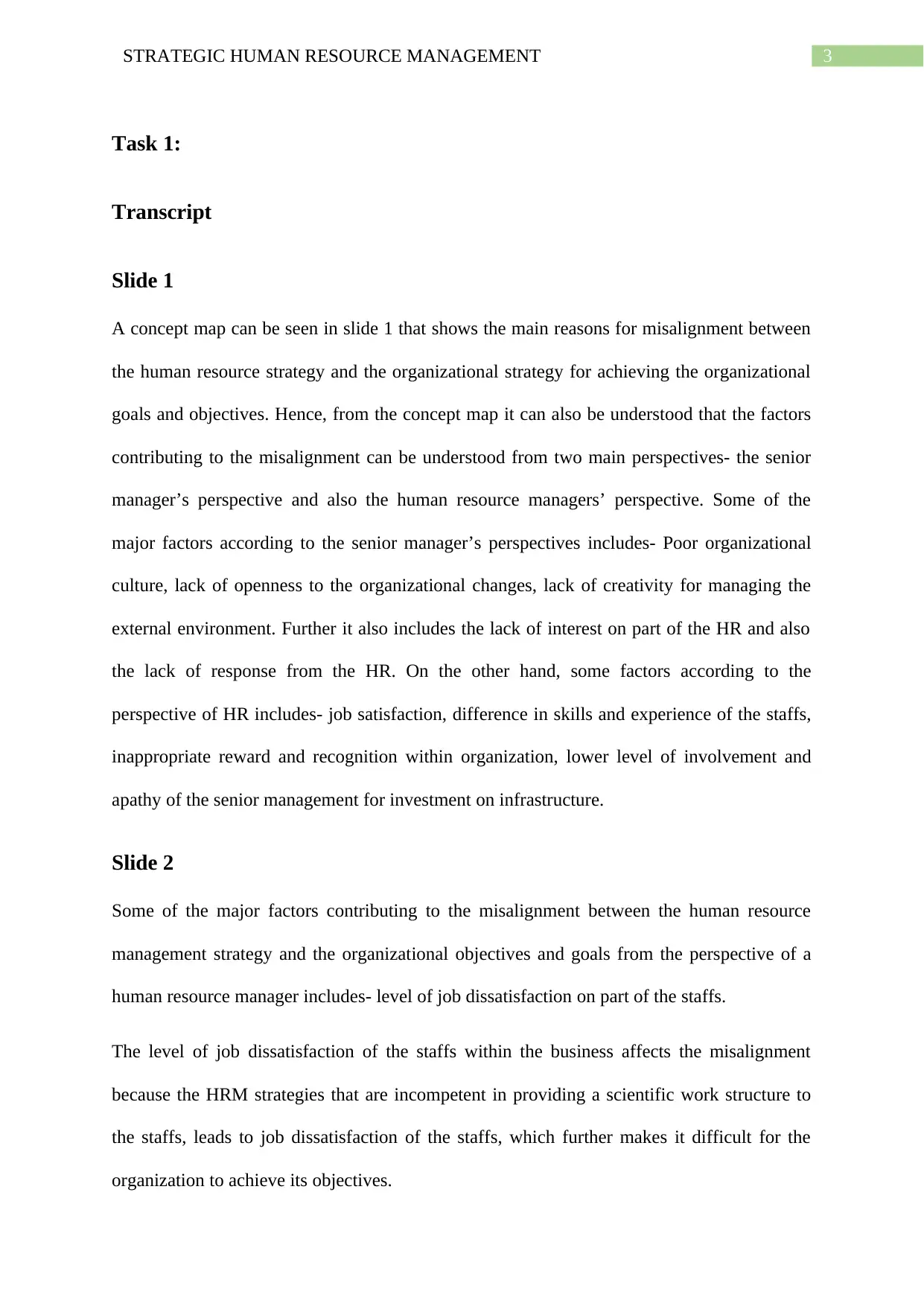
3STRATEGIC HUMAN RESOURCE MANAGEMENT
Task 1:
Transcript
Slide 1
A concept map can be seen in slide 1 that shows the main reasons for misalignment between
the human resource strategy and the organizational strategy for achieving the organizational
goals and objectives. Hence, from the concept map it can also be understood that the factors
contributing to the misalignment can be understood from two main perspectives- the senior
manager’s perspective and also the human resource managers’ perspective. Some of the
major factors according to the senior manager’s perspectives includes- Poor organizational
culture, lack of openness to the organizational changes, lack of creativity for managing the
external environment. Further it also includes the lack of interest on part of the HR and also
the lack of response from the HR. On the other hand, some factors according to the
perspective of HR includes- job satisfaction, difference in skills and experience of the staffs,
inappropriate reward and recognition within organization, lower level of involvement and
apathy of the senior management for investment on infrastructure.
Slide 2
Some of the major factors contributing to the misalignment between the human resource
management strategy and the organizational objectives and goals from the perspective of a
human resource manager includes- level of job dissatisfaction on part of the staffs.
The level of job dissatisfaction of the staffs within the business affects the misalignment
because the HRM strategies that are incompetent in providing a scientific work structure to
the staffs, leads to job dissatisfaction of the staffs, which further makes it difficult for the
organization to achieve its objectives.
Task 1:
Transcript
Slide 1
A concept map can be seen in slide 1 that shows the main reasons for misalignment between
the human resource strategy and the organizational strategy for achieving the organizational
goals and objectives. Hence, from the concept map it can also be understood that the factors
contributing to the misalignment can be understood from two main perspectives- the senior
manager’s perspective and also the human resource managers’ perspective. Some of the
major factors according to the senior manager’s perspectives includes- Poor organizational
culture, lack of openness to the organizational changes, lack of creativity for managing the
external environment. Further it also includes the lack of interest on part of the HR and also
the lack of response from the HR. On the other hand, some factors according to the
perspective of HR includes- job satisfaction, difference in skills and experience of the staffs,
inappropriate reward and recognition within organization, lower level of involvement and
apathy of the senior management for investment on infrastructure.
Slide 2
Some of the major factors contributing to the misalignment between the human resource
management strategy and the organizational objectives and goals from the perspective of a
human resource manager includes- level of job dissatisfaction on part of the staffs.
The level of job dissatisfaction of the staffs within the business affects the misalignment
because the HRM strategies that are incompetent in providing a scientific work structure to
the staffs, leads to job dissatisfaction of the staffs, which further makes it difficult for the
organization to achieve its objectives.
Paraphrase This Document
Need a fresh take? Get an instant paraphrase of this document with our AI Paraphraser
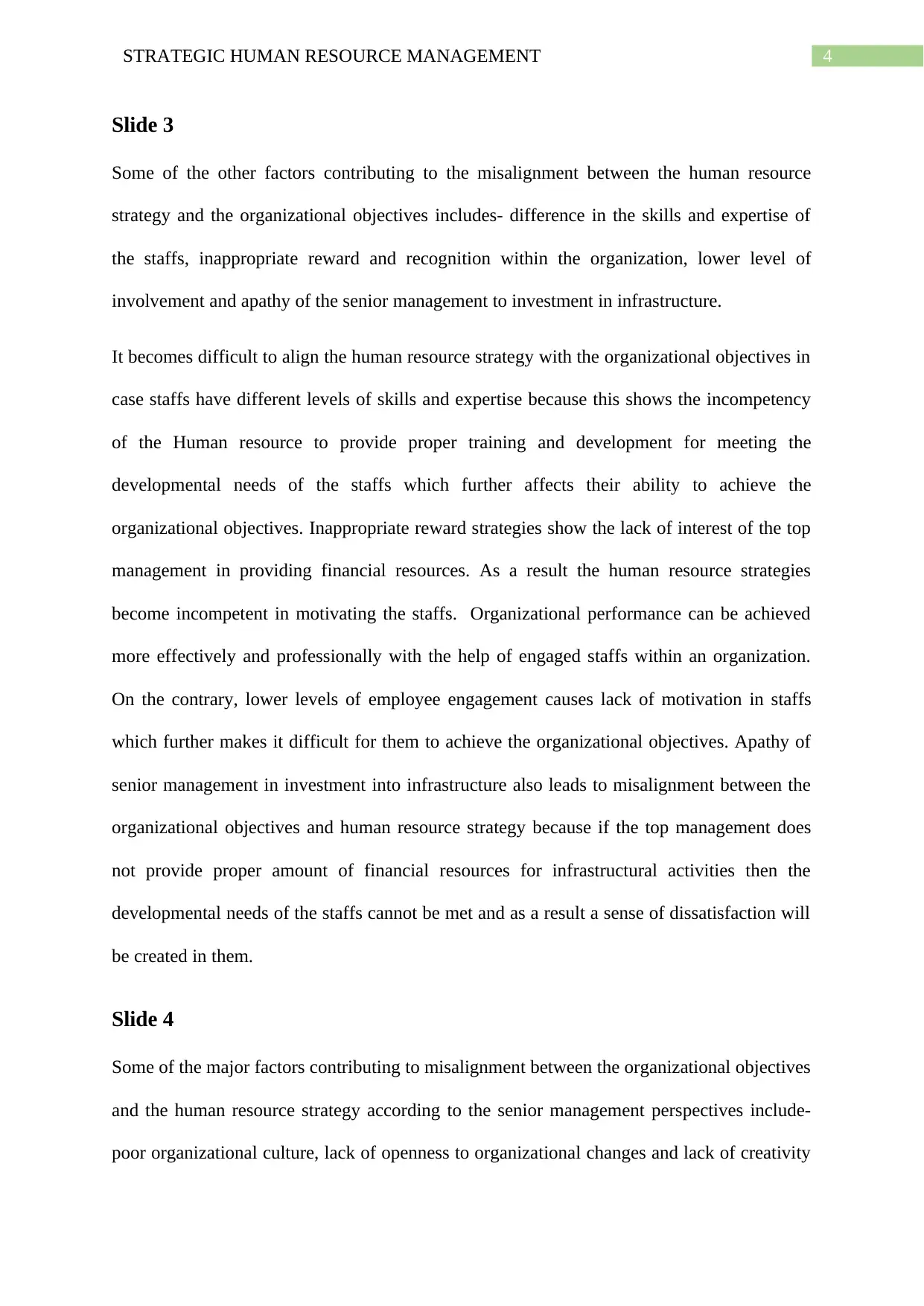
4STRATEGIC HUMAN RESOURCE MANAGEMENT
Slide 3
Some of the other factors contributing to the misalignment between the human resource
strategy and the organizational objectives includes- difference in the skills and expertise of
the staffs, inappropriate reward and recognition within the organization, lower level of
involvement and apathy of the senior management to investment in infrastructure.
It becomes difficult to align the human resource strategy with the organizational objectives in
case staffs have different levels of skills and expertise because this shows the incompetency
of the Human resource to provide proper training and development for meeting the
developmental needs of the staffs which further affects their ability to achieve the
organizational objectives. Inappropriate reward strategies show the lack of interest of the top
management in providing financial resources. As a result the human resource strategies
become incompetent in motivating the staffs. Organizational performance can be achieved
more effectively and professionally with the help of engaged staffs within an organization.
On the contrary, lower levels of employee engagement causes lack of motivation in staffs
which further makes it difficult for them to achieve the organizational objectives. Apathy of
senior management in investment into infrastructure also leads to misalignment between the
organizational objectives and human resource strategy because if the top management does
not provide proper amount of financial resources for infrastructural activities then the
developmental needs of the staffs cannot be met and as a result a sense of dissatisfaction will
be created in them.
Slide 4
Some of the major factors contributing to misalignment between the organizational objectives
and the human resource strategy according to the senior management perspectives include-
poor organizational culture, lack of openness to organizational changes and lack of creativity
Slide 3
Some of the other factors contributing to the misalignment between the human resource
strategy and the organizational objectives includes- difference in the skills and expertise of
the staffs, inappropriate reward and recognition within the organization, lower level of
involvement and apathy of the senior management to investment in infrastructure.
It becomes difficult to align the human resource strategy with the organizational objectives in
case staffs have different levels of skills and expertise because this shows the incompetency
of the Human resource to provide proper training and development for meeting the
developmental needs of the staffs which further affects their ability to achieve the
organizational objectives. Inappropriate reward strategies show the lack of interest of the top
management in providing financial resources. As a result the human resource strategies
become incompetent in motivating the staffs. Organizational performance can be achieved
more effectively and professionally with the help of engaged staffs within an organization.
On the contrary, lower levels of employee engagement causes lack of motivation in staffs
which further makes it difficult for them to achieve the organizational objectives. Apathy of
senior management in investment into infrastructure also leads to misalignment between the
organizational objectives and human resource strategy because if the top management does
not provide proper amount of financial resources for infrastructural activities then the
developmental needs of the staffs cannot be met and as a result a sense of dissatisfaction will
be created in them.
Slide 4
Some of the major factors contributing to misalignment between the organizational objectives
and the human resource strategy according to the senior management perspectives include-
poor organizational culture, lack of openness to organizational changes and lack of creativity
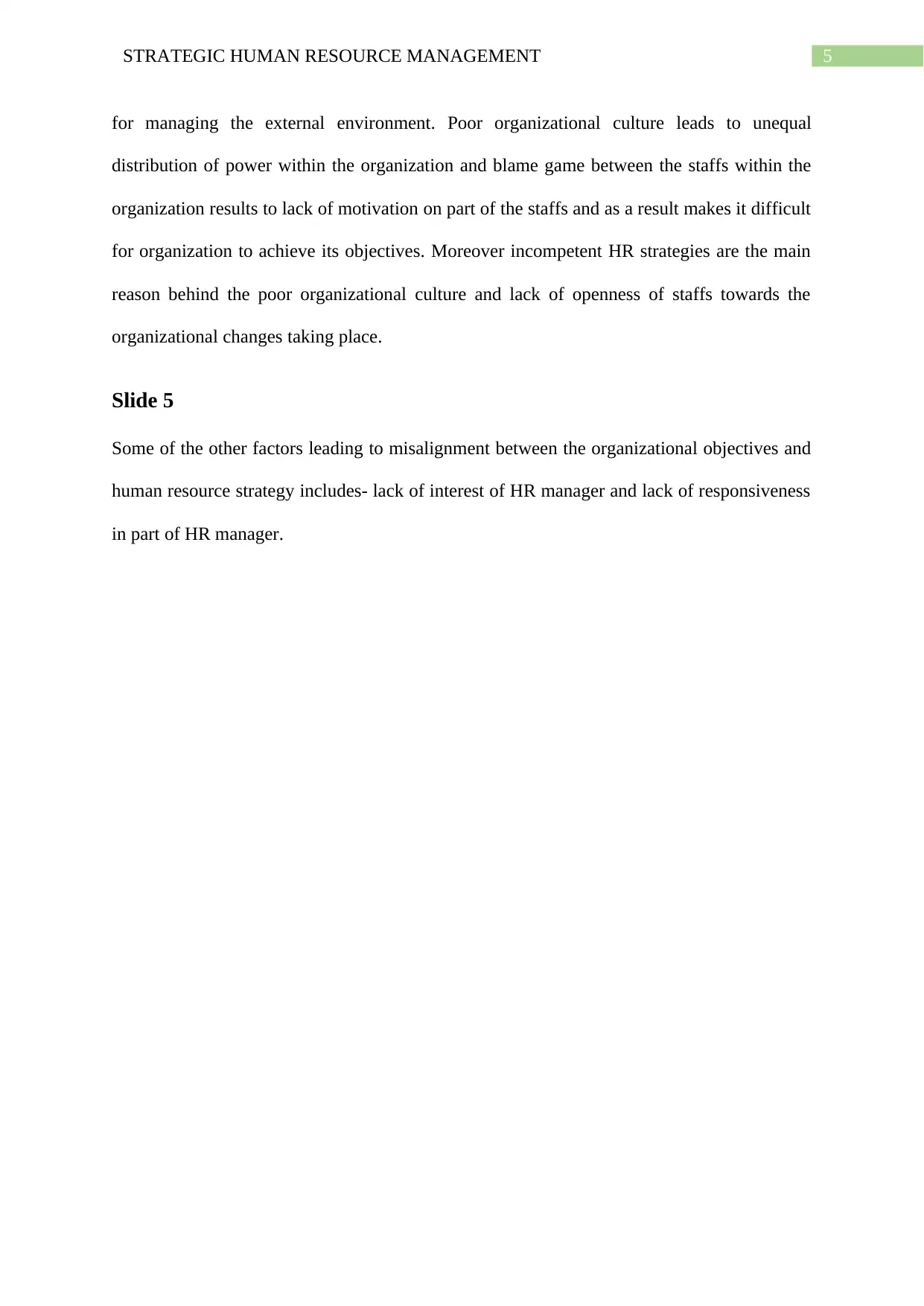
5STRATEGIC HUMAN RESOURCE MANAGEMENT
for managing the external environment. Poor organizational culture leads to unequal
distribution of power within the organization and blame game between the staffs within the
organization results to lack of motivation on part of the staffs and as a result makes it difficult
for organization to achieve its objectives. Moreover incompetent HR strategies are the main
reason behind the poor organizational culture and lack of openness of staffs towards the
organizational changes taking place.
Slide 5
Some of the other factors leading to misalignment between the organizational objectives and
human resource strategy includes- lack of interest of HR manager and lack of responsiveness
in part of HR manager.
for managing the external environment. Poor organizational culture leads to unequal
distribution of power within the organization and blame game between the staffs within the
organization results to lack of motivation on part of the staffs and as a result makes it difficult
for organization to achieve its objectives. Moreover incompetent HR strategies are the main
reason behind the poor organizational culture and lack of openness of staffs towards the
organizational changes taking place.
Slide 5
Some of the other factors leading to misalignment between the organizational objectives and
human resource strategy includes- lack of interest of HR manager and lack of responsiveness
in part of HR manager.
⊘ This is a preview!⊘
Do you want full access?
Subscribe today to unlock all pages.

Trusted by 1+ million students worldwide
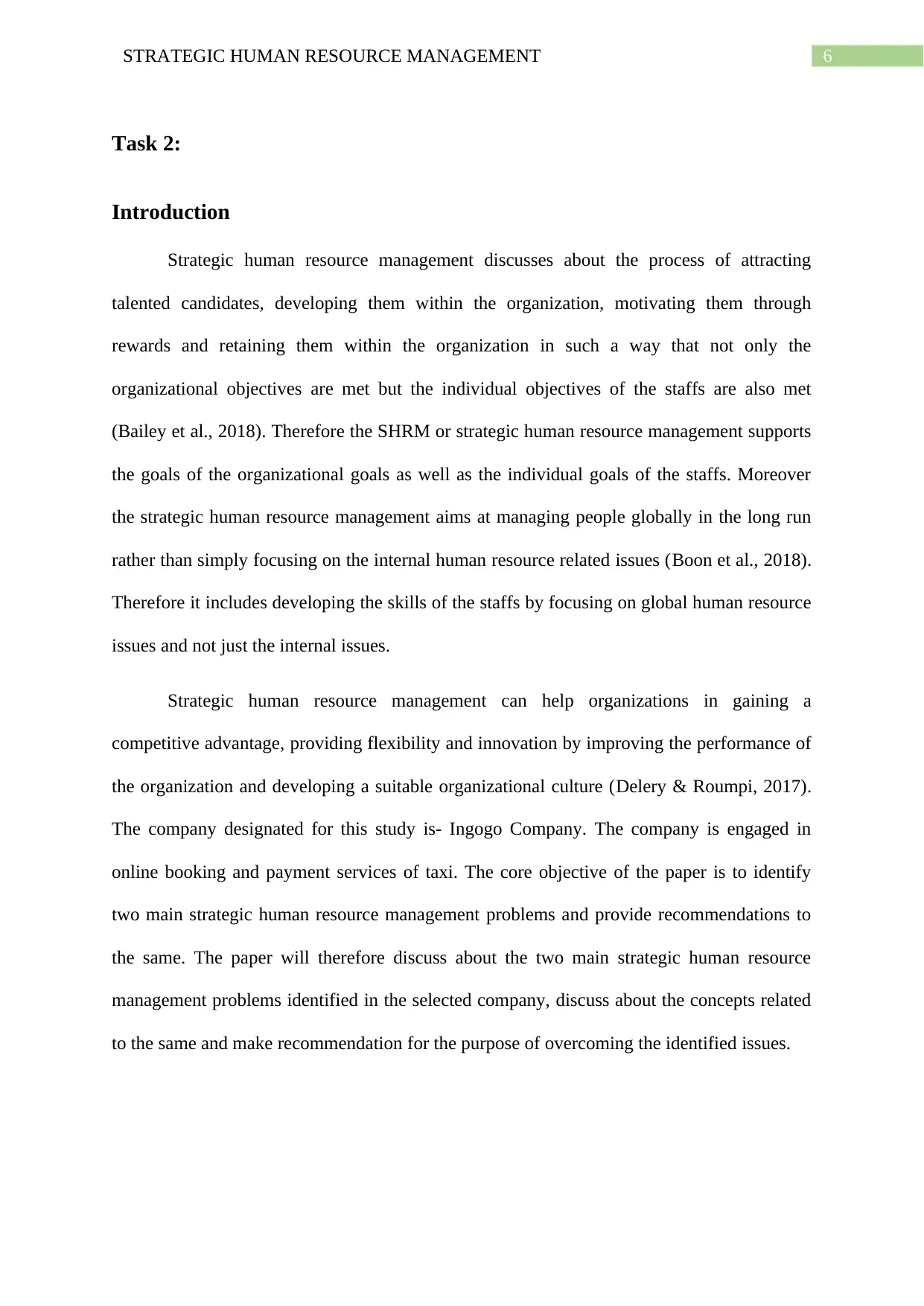
6STRATEGIC HUMAN RESOURCE MANAGEMENT
Task 2:
Introduction
Strategic human resource management discusses about the process of attracting
talented candidates, developing them within the organization, motivating them through
rewards and retaining them within the organization in such a way that not only the
organizational objectives are met but the individual objectives of the staffs are also met
(Bailey et al., 2018). Therefore the SHRM or strategic human resource management supports
the goals of the organizational goals as well as the individual goals of the staffs. Moreover
the strategic human resource management aims at managing people globally in the long run
rather than simply focusing on the internal human resource related issues (Boon et al., 2018).
Therefore it includes developing the skills of the staffs by focusing on global human resource
issues and not just the internal issues.
Strategic human resource management can help organizations in gaining a
competitive advantage, providing flexibility and innovation by improving the performance of
the organization and developing a suitable organizational culture (Delery & Roumpi, 2017).
The company designated for this study is- Ingogo Company. The company is engaged in
online booking and payment services of taxi. The core objective of the paper is to identify
two main strategic human resource management problems and provide recommendations to
the same. The paper will therefore discuss about the two main strategic human resource
management problems identified in the selected company, discuss about the concepts related
to the same and make recommendation for the purpose of overcoming the identified issues.
Task 2:
Introduction
Strategic human resource management discusses about the process of attracting
talented candidates, developing them within the organization, motivating them through
rewards and retaining them within the organization in such a way that not only the
organizational objectives are met but the individual objectives of the staffs are also met
(Bailey et al., 2018). Therefore the SHRM or strategic human resource management supports
the goals of the organizational goals as well as the individual goals of the staffs. Moreover
the strategic human resource management aims at managing people globally in the long run
rather than simply focusing on the internal human resource related issues (Boon et al., 2018).
Therefore it includes developing the skills of the staffs by focusing on global human resource
issues and not just the internal issues.
Strategic human resource management can help organizations in gaining a
competitive advantage, providing flexibility and innovation by improving the performance of
the organization and developing a suitable organizational culture (Delery & Roumpi, 2017).
The company designated for this study is- Ingogo Company. The company is engaged in
online booking and payment services of taxi. The core objective of the paper is to identify
two main strategic human resource management problems and provide recommendations to
the same. The paper will therefore discuss about the two main strategic human resource
management problems identified in the selected company, discuss about the concepts related
to the same and make recommendation for the purpose of overcoming the identified issues.
Paraphrase This Document
Need a fresh take? Get an instant paraphrase of this document with our AI Paraphraser
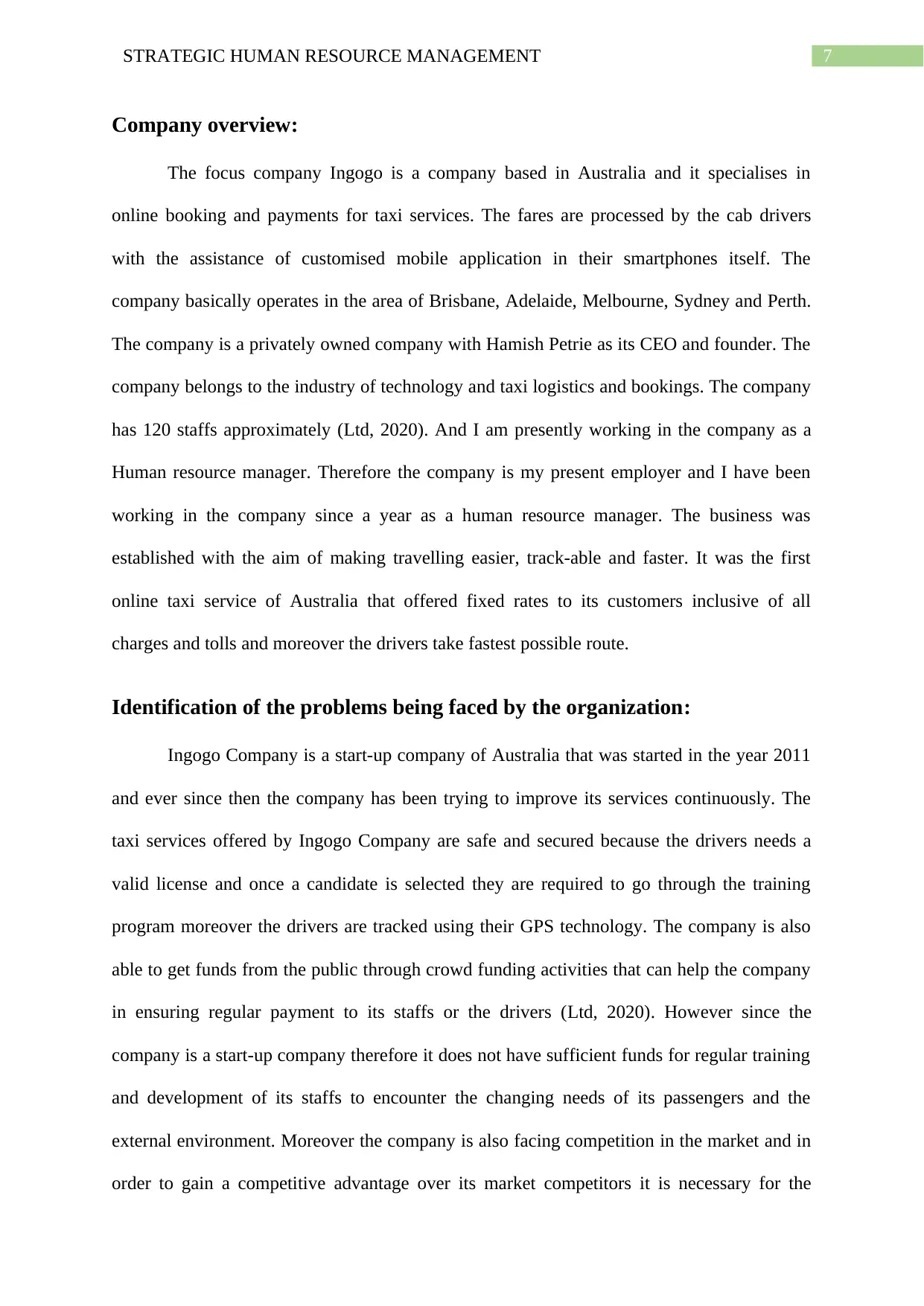
7STRATEGIC HUMAN RESOURCE MANAGEMENT
Company overview:
The focus company Ingogo is a company based in Australia and it specialises in
online booking and payments for taxi services. The fares are processed by the cab drivers
with the assistance of customised mobile application in their smartphones itself. The
company basically operates in the area of Brisbane, Adelaide, Melbourne, Sydney and Perth.
The company is a privately owned company with Hamish Petrie as its CEO and founder. The
company belongs to the industry of technology and taxi logistics and bookings. The company
has 120 staffs approximately (Ltd, 2020). And I am presently working in the company as a
Human resource manager. Therefore the company is my present employer and I have been
working in the company since a year as a human resource manager. The business was
established with the aim of making travelling easier, track-able and faster. It was the first
online taxi service of Australia that offered fixed rates to its customers inclusive of all
charges and tolls and moreover the drivers take fastest possible route.
Identification of the problems being faced by the organization:
Ingogo Company is a start-up company of Australia that was started in the year 2011
and ever since then the company has been trying to improve its services continuously. The
taxi services offered by Ingogo Company are safe and secured because the drivers needs a
valid license and once a candidate is selected they are required to go through the training
program moreover the drivers are tracked using their GPS technology. The company is also
able to get funds from the public through crowd funding activities that can help the company
in ensuring regular payment to its staffs or the drivers (Ltd, 2020). However since the
company is a start-up company therefore it does not have sufficient funds for regular training
and development of its staffs to encounter the changing needs of its passengers and the
external environment. Moreover the company is also facing competition in the market and in
order to gain a competitive advantage over its market competitors it is necessary for the
Company overview:
The focus company Ingogo is a company based in Australia and it specialises in
online booking and payments for taxi services. The fares are processed by the cab drivers
with the assistance of customised mobile application in their smartphones itself. The
company basically operates in the area of Brisbane, Adelaide, Melbourne, Sydney and Perth.
The company is a privately owned company with Hamish Petrie as its CEO and founder. The
company belongs to the industry of technology and taxi logistics and bookings. The company
has 120 staffs approximately (Ltd, 2020). And I am presently working in the company as a
Human resource manager. Therefore the company is my present employer and I have been
working in the company since a year as a human resource manager. The business was
established with the aim of making travelling easier, track-able and faster. It was the first
online taxi service of Australia that offered fixed rates to its customers inclusive of all
charges and tolls and moreover the drivers take fastest possible route.
Identification of the problems being faced by the organization:
Ingogo Company is a start-up company of Australia that was started in the year 2011
and ever since then the company has been trying to improve its services continuously. The
taxi services offered by Ingogo Company are safe and secured because the drivers needs a
valid license and once a candidate is selected they are required to go through the training
program moreover the drivers are tracked using their GPS technology. The company is also
able to get funds from the public through crowd funding activities that can help the company
in ensuring regular payment to its staffs or the drivers (Ltd, 2020). However since the
company is a start-up company therefore it does not have sufficient funds for regular training
and development of its staffs to encounter the changing needs of its passengers and the
external environment. Moreover the company is also facing competition in the market and in
order to gain a competitive advantage over its market competitors it is necessary for the
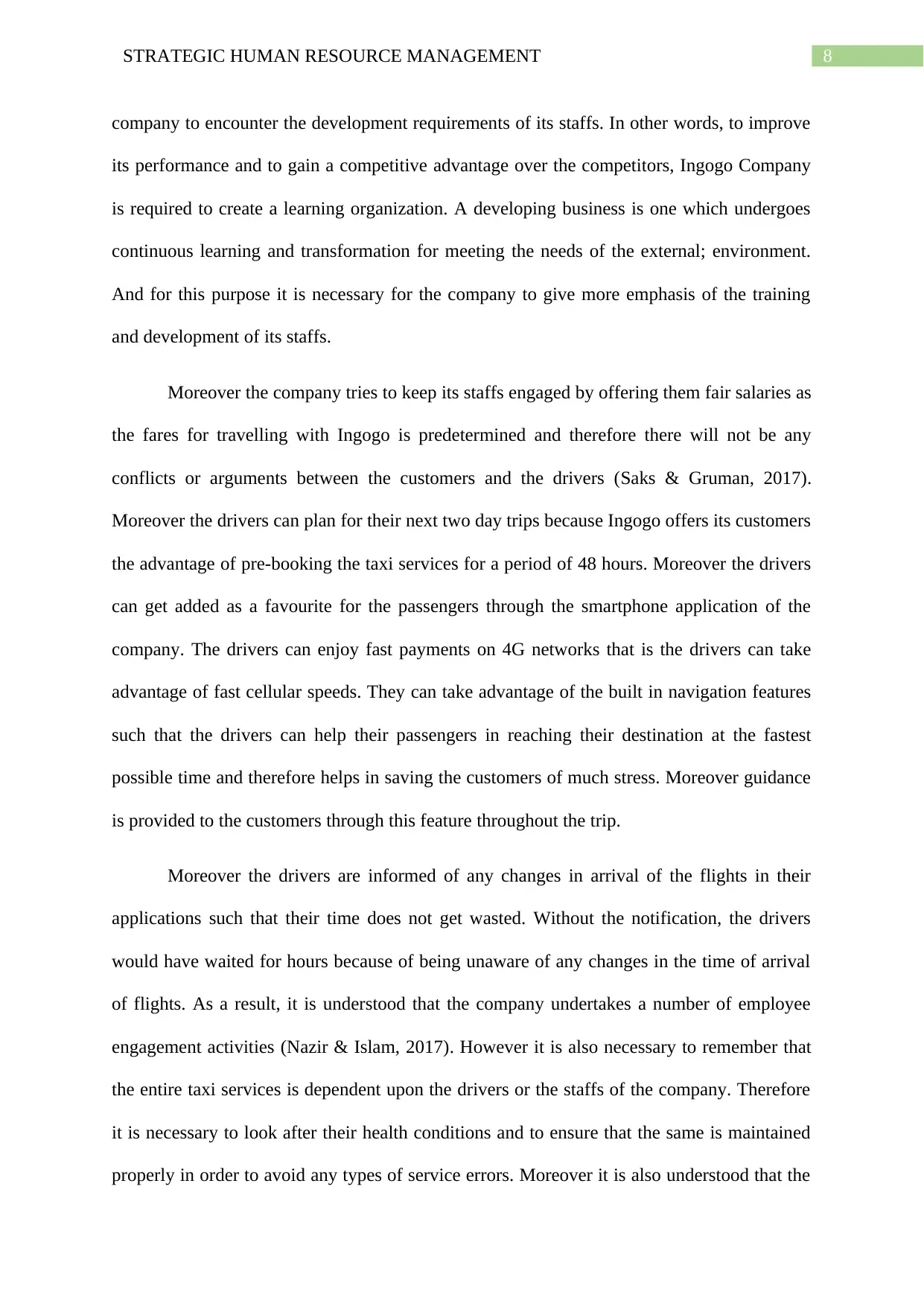
8STRATEGIC HUMAN RESOURCE MANAGEMENT
company to encounter the development requirements of its staffs. In other words, to improve
its performance and to gain a competitive advantage over the competitors, Ingogo Company
is required to create a learning organization. A developing business is one which undergoes
continuous learning and transformation for meeting the needs of the external; environment.
And for this purpose it is necessary for the company to give more emphasis of the training
and development of its staffs.
Moreover the company tries to keep its staffs engaged by offering them fair salaries as
the fares for travelling with Ingogo is predetermined and therefore there will not be any
conflicts or arguments between the customers and the drivers (Saks & Gruman, 2017).
Moreover the drivers can plan for their next two day trips because Ingogo offers its customers
the advantage of pre-booking the taxi services for a period of 48 hours. Moreover the drivers
can get added as a favourite for the passengers through the smartphone application of the
company. The drivers can enjoy fast payments on 4G networks that is the drivers can take
advantage of fast cellular speeds. They can take advantage of the built in navigation features
such that the drivers can help their passengers in reaching their destination at the fastest
possible time and therefore helps in saving the customers of much stress. Moreover guidance
is provided to the customers through this feature throughout the trip.
Moreover the drivers are informed of any changes in arrival of the flights in their
applications such that their time does not get wasted. Without the notification, the drivers
would have waited for hours because of being unaware of any changes in the time of arrival
of flights. As a result, it is understood that the company undertakes a number of employee
engagement activities (Nazir & Islam, 2017). However it is also necessary to remember that
the entire taxi services is dependent upon the drivers or the staffs of the company. Therefore
it is necessary to look after their health conditions and to ensure that the same is maintained
properly in order to avoid any types of service errors. Moreover it is also understood that the
company to encounter the development requirements of its staffs. In other words, to improve
its performance and to gain a competitive advantage over the competitors, Ingogo Company
is required to create a learning organization. A developing business is one which undergoes
continuous learning and transformation for meeting the needs of the external; environment.
And for this purpose it is necessary for the company to give more emphasis of the training
and development of its staffs.
Moreover the company tries to keep its staffs engaged by offering them fair salaries as
the fares for travelling with Ingogo is predetermined and therefore there will not be any
conflicts or arguments between the customers and the drivers (Saks & Gruman, 2017).
Moreover the drivers can plan for their next two day trips because Ingogo offers its customers
the advantage of pre-booking the taxi services for a period of 48 hours. Moreover the drivers
can get added as a favourite for the passengers through the smartphone application of the
company. The drivers can enjoy fast payments on 4G networks that is the drivers can take
advantage of fast cellular speeds. They can take advantage of the built in navigation features
such that the drivers can help their passengers in reaching their destination at the fastest
possible time and therefore helps in saving the customers of much stress. Moreover guidance
is provided to the customers through this feature throughout the trip.
Moreover the drivers are informed of any changes in arrival of the flights in their
applications such that their time does not get wasted. Without the notification, the drivers
would have waited for hours because of being unaware of any changes in the time of arrival
of flights. As a result, it is understood that the company undertakes a number of employee
engagement activities (Nazir & Islam, 2017). However it is also necessary to remember that
the entire taxi services is dependent upon the drivers or the staffs of the company. Therefore
it is necessary to look after their health conditions and to ensure that the same is maintained
properly in order to avoid any types of service errors. Moreover it is also understood that the
⊘ This is a preview!⊘
Do you want full access?
Subscribe today to unlock all pages.

Trusted by 1+ million students worldwide
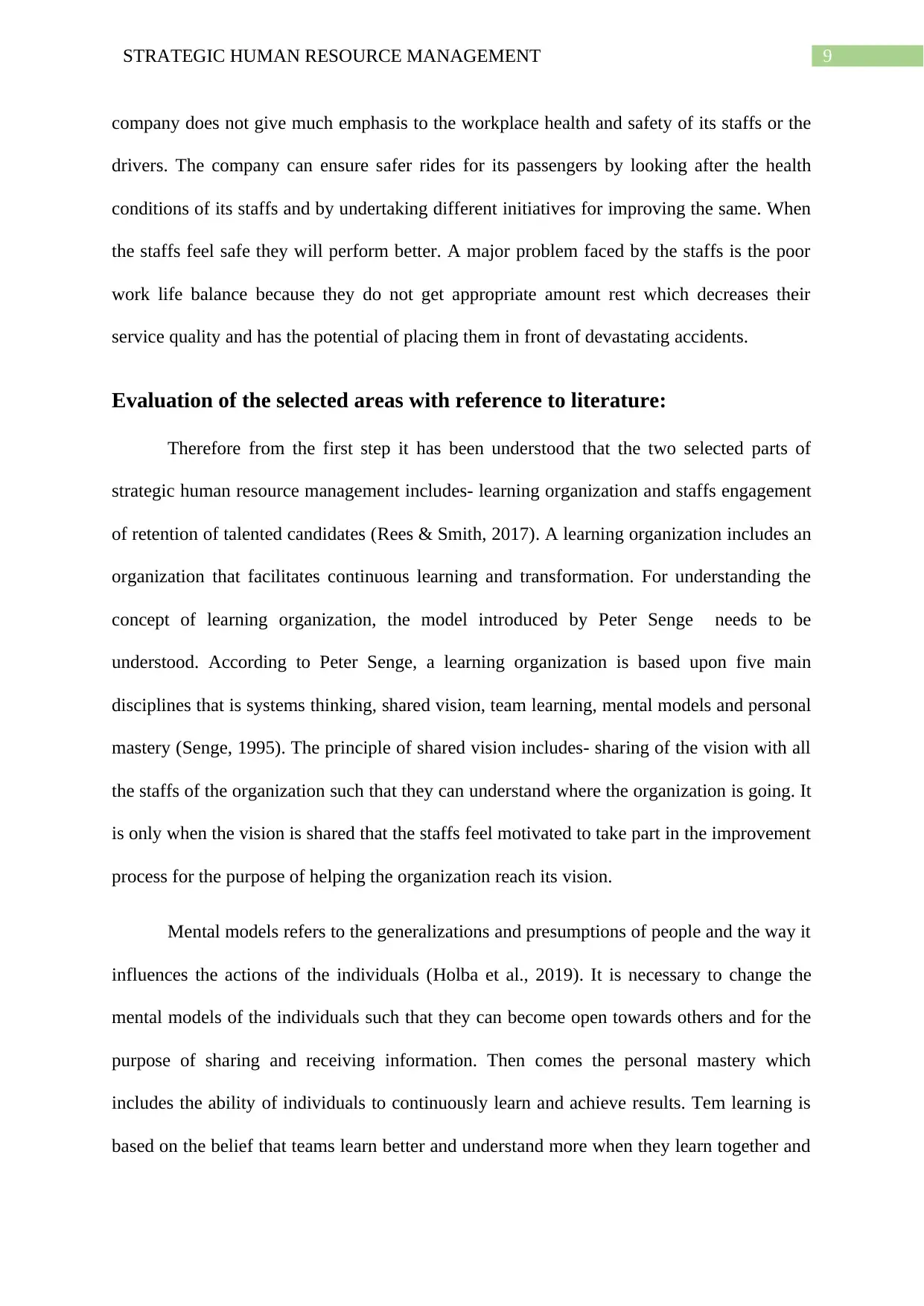
9STRATEGIC HUMAN RESOURCE MANAGEMENT
company does not give much emphasis to the workplace health and safety of its staffs or the
drivers. The company can ensure safer rides for its passengers by looking after the health
conditions of its staffs and by undertaking different initiatives for improving the same. When
the staffs feel safe they will perform better. A major problem faced by the staffs is the poor
work life balance because they do not get appropriate amount rest which decreases their
service quality and has the potential of placing them in front of devastating accidents.
Evaluation of the selected areas with reference to literature:
Therefore from the first step it has been understood that the two selected parts of
strategic human resource management includes- learning organization and staffs engagement
of retention of talented candidates (Rees & Smith, 2017). A learning organization includes an
organization that facilitates continuous learning and transformation. For understanding the
concept of learning organization, the model introduced by Peter Senge needs to be
understood. According to Peter Senge, a learning organization is based upon five main
disciplines that is systems thinking, shared vision, team learning, mental models and personal
mastery (Senge, 1995). The principle of shared vision includes- sharing of the vision with all
the staffs of the organization such that they can understand where the organization is going. It
is only when the vision is shared that the staffs feel motivated to take part in the improvement
process for the purpose of helping the organization reach its vision.
Mental models refers to the generalizations and presumptions of people and the way it
influences the actions of the individuals (Holba et al., 2019). It is necessary to change the
mental models of the individuals such that they can become open towards others and for the
purpose of sharing and receiving information. Then comes the personal mastery which
includes the ability of individuals to continuously learn and achieve results. Tem learning is
based on the belief that teams learn better and understand more when they learn together and
company does not give much emphasis to the workplace health and safety of its staffs or the
drivers. The company can ensure safer rides for its passengers by looking after the health
conditions of its staffs and by undertaking different initiatives for improving the same. When
the staffs feel safe they will perform better. A major problem faced by the staffs is the poor
work life balance because they do not get appropriate amount rest which decreases their
service quality and has the potential of placing them in front of devastating accidents.
Evaluation of the selected areas with reference to literature:
Therefore from the first step it has been understood that the two selected parts of
strategic human resource management includes- learning organization and staffs engagement
of retention of talented candidates (Rees & Smith, 2017). A learning organization includes an
organization that facilitates continuous learning and transformation. For understanding the
concept of learning organization, the model introduced by Peter Senge needs to be
understood. According to Peter Senge, a learning organization is based upon five main
disciplines that is systems thinking, shared vision, team learning, mental models and personal
mastery (Senge, 1995). The principle of shared vision includes- sharing of the vision with all
the staffs of the organization such that they can understand where the organization is going. It
is only when the vision is shared that the staffs feel motivated to take part in the improvement
process for the purpose of helping the organization reach its vision.
Mental models refers to the generalizations and presumptions of people and the way it
influences the actions of the individuals (Holba et al., 2019). It is necessary to change the
mental models of the individuals such that they can become open towards others and for the
purpose of sharing and receiving information. Then comes the personal mastery which
includes the ability of individuals to continuously learn and achieve results. Tem learning is
based on the belief that teams learn better and understand more when they learn together and
Paraphrase This Document
Need a fresh take? Get an instant paraphrase of this document with our AI Paraphraser
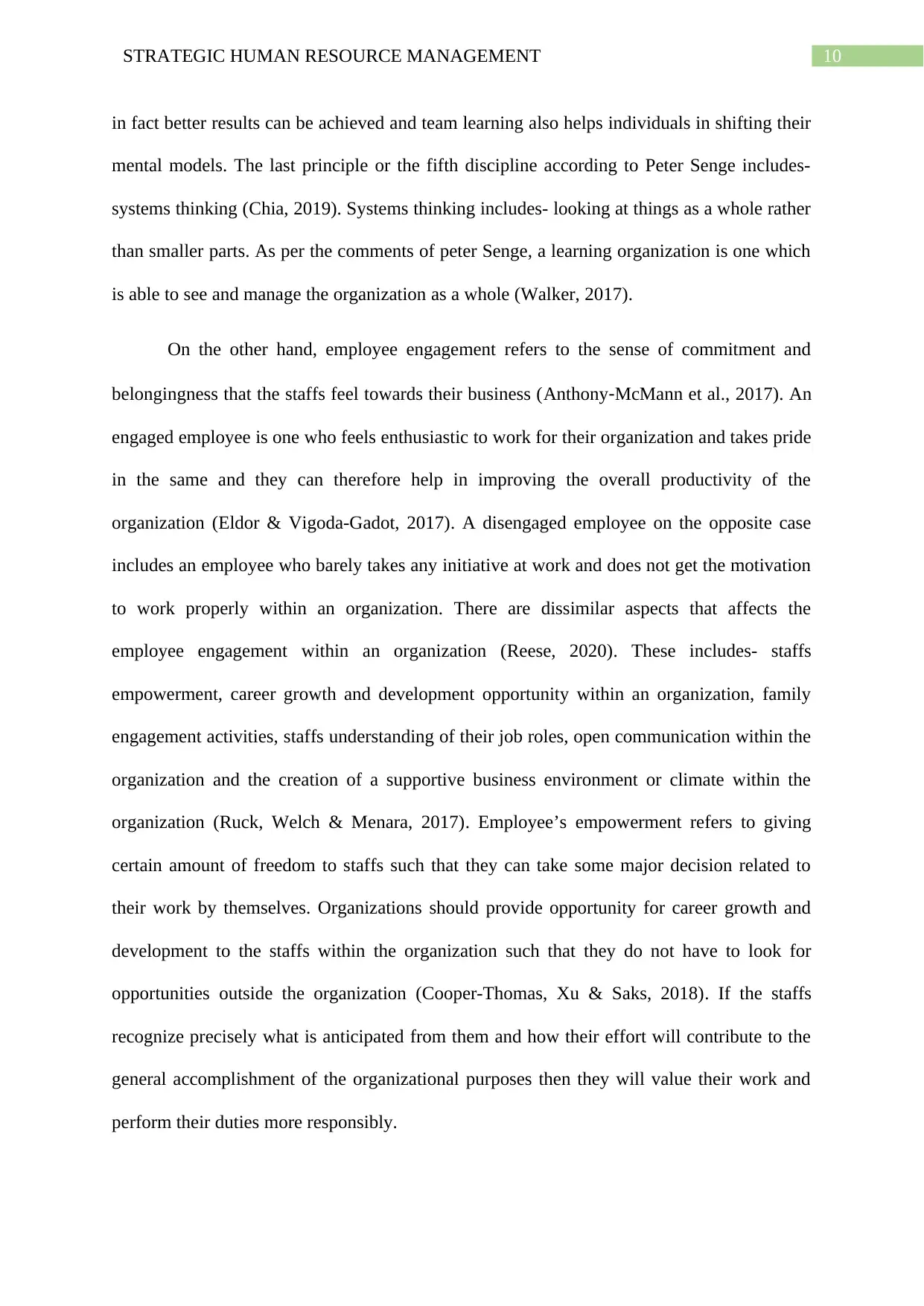
10STRATEGIC HUMAN RESOURCE MANAGEMENT
in fact better results can be achieved and team learning also helps individuals in shifting their
mental models. The last principle or the fifth discipline according to Peter Senge includes-
systems thinking (Chia, 2019). Systems thinking includes- looking at things as a whole rather
than smaller parts. As per the comments of peter Senge, a learning organization is one which
is able to see and manage the organization as a whole (Walker, 2017).
On the other hand, employee engagement refers to the sense of commitment and
belongingness that the staffs feel towards their business (Anthony‐McMann et al., 2017). An
engaged employee is one who feels enthusiastic to work for their organization and takes pride
in the same and they can therefore help in improving the overall productivity of the
organization (Eldor & Vigoda-Gadot, 2017). A disengaged employee on the opposite case
includes an employee who barely takes any initiative at work and does not get the motivation
to work properly within an organization. There are dissimilar aspects that affects the
employee engagement within an organization (Reese, 2020). These includes- staffs
empowerment, career growth and development opportunity within an organization, family
engagement activities, staffs understanding of their job roles, open communication within the
organization and the creation of a supportive business environment or climate within the
organization (Ruck, Welch & Menara, 2017). Employee’s empowerment refers to giving
certain amount of freedom to staffs such that they can take some major decision related to
their work by themselves. Organizations should provide opportunity for career growth and
development to the staffs within the organization such that they do not have to look for
opportunities outside the organization (Cooper-Thomas, Xu & Saks, 2018). If the staffs
recognize precisely what is anticipated from them and how their effort will contribute to the
general accomplishment of the organizational purposes then they will value their work and
perform their duties more responsibly.
in fact better results can be achieved and team learning also helps individuals in shifting their
mental models. The last principle or the fifth discipline according to Peter Senge includes-
systems thinking (Chia, 2019). Systems thinking includes- looking at things as a whole rather
than smaller parts. As per the comments of peter Senge, a learning organization is one which
is able to see and manage the organization as a whole (Walker, 2017).
On the other hand, employee engagement refers to the sense of commitment and
belongingness that the staffs feel towards their business (Anthony‐McMann et al., 2017). An
engaged employee is one who feels enthusiastic to work for their organization and takes pride
in the same and they can therefore help in improving the overall productivity of the
organization (Eldor & Vigoda-Gadot, 2017). A disengaged employee on the opposite case
includes an employee who barely takes any initiative at work and does not get the motivation
to work properly within an organization. There are dissimilar aspects that affects the
employee engagement within an organization (Reese, 2020). These includes- staffs
empowerment, career growth and development opportunity within an organization, family
engagement activities, staffs understanding of their job roles, open communication within the
organization and the creation of a supportive business environment or climate within the
organization (Ruck, Welch & Menara, 2017). Employee’s empowerment refers to giving
certain amount of freedom to staffs such that they can take some major decision related to
their work by themselves. Organizations should provide opportunity for career growth and
development to the staffs within the organization such that they do not have to look for
opportunities outside the organization (Cooper-Thomas, Xu & Saks, 2018). If the staffs
recognize precisely what is anticipated from them and how their effort will contribute to the
general accomplishment of the organizational purposes then they will value their work and
perform their duties more responsibly.
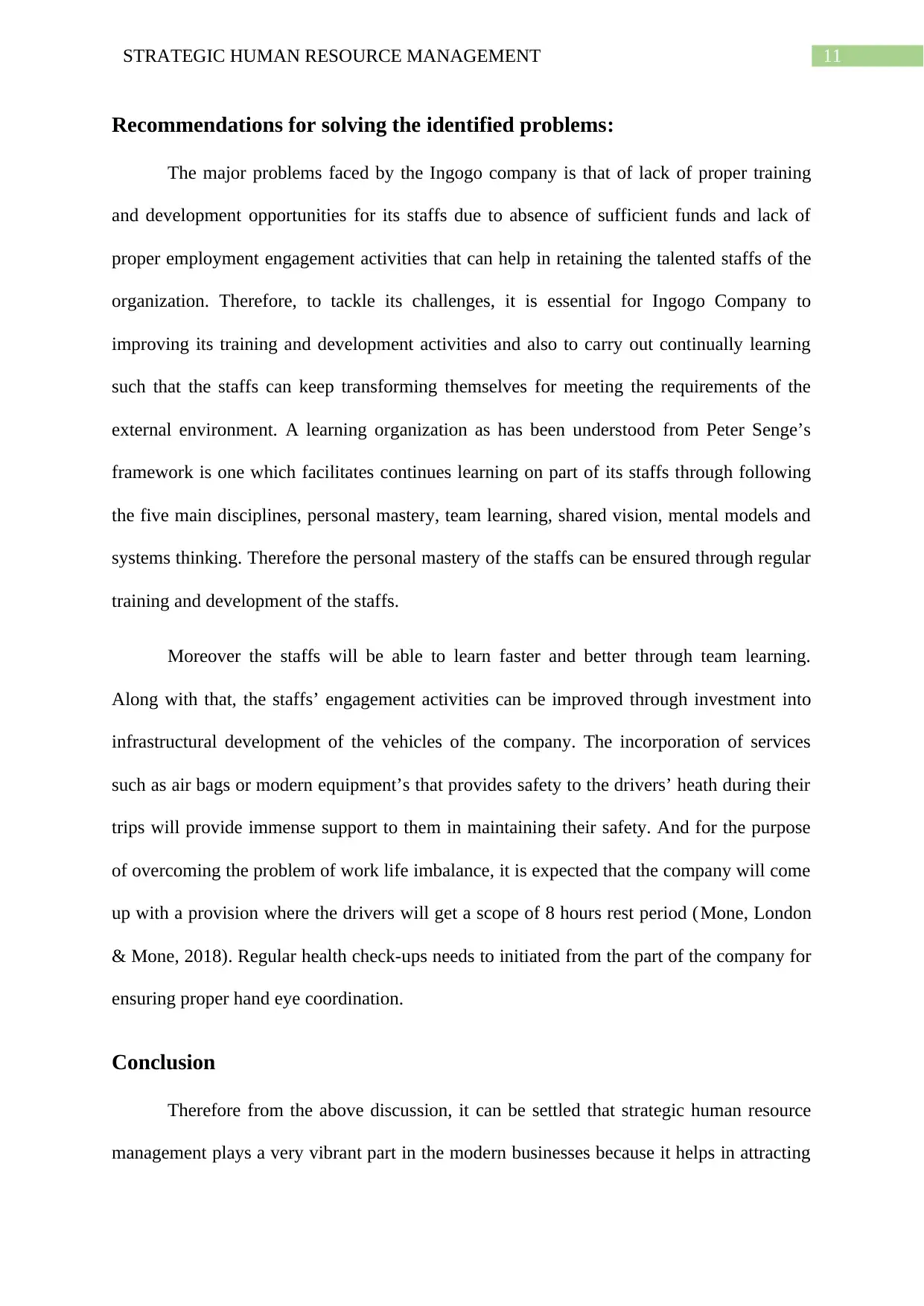
11STRATEGIC HUMAN RESOURCE MANAGEMENT
Recommendations for solving the identified problems:
The major problems faced by the Ingogo company is that of lack of proper training
and development opportunities for its staffs due to absence of sufficient funds and lack of
proper employment engagement activities that can help in retaining the talented staffs of the
organization. Therefore, to tackle its challenges, it is essential for Ingogo Company to
improving its training and development activities and also to carry out continually learning
such that the staffs can keep transforming themselves for meeting the requirements of the
external environment. A learning organization as has been understood from Peter Senge’s
framework is one which facilitates continues learning on part of its staffs through following
the five main disciplines, personal mastery, team learning, shared vision, mental models and
systems thinking. Therefore the personal mastery of the staffs can be ensured through regular
training and development of the staffs.
Moreover the staffs will be able to learn faster and better through team learning.
Along with that, the staffs’ engagement activities can be improved through investment into
infrastructural development of the vehicles of the company. The incorporation of services
such as air bags or modern equipment’s that provides safety to the drivers’ heath during their
trips will provide immense support to them in maintaining their safety. And for the purpose
of overcoming the problem of work life imbalance, it is expected that the company will come
up with a provision where the drivers will get a scope of 8 hours rest period (Mone, London
& Mone, 2018). Regular health check-ups needs to initiated from the part of the company for
ensuring proper hand eye coordination.
Conclusion
Therefore from the above discussion, it can be settled that strategic human resource
management plays a very vibrant part in the modern businesses because it helps in attracting
Recommendations for solving the identified problems:
The major problems faced by the Ingogo company is that of lack of proper training
and development opportunities for its staffs due to absence of sufficient funds and lack of
proper employment engagement activities that can help in retaining the talented staffs of the
organization. Therefore, to tackle its challenges, it is essential for Ingogo Company to
improving its training and development activities and also to carry out continually learning
such that the staffs can keep transforming themselves for meeting the requirements of the
external environment. A learning organization as has been understood from Peter Senge’s
framework is one which facilitates continues learning on part of its staffs through following
the five main disciplines, personal mastery, team learning, shared vision, mental models and
systems thinking. Therefore the personal mastery of the staffs can be ensured through regular
training and development of the staffs.
Moreover the staffs will be able to learn faster and better through team learning.
Along with that, the staffs’ engagement activities can be improved through investment into
infrastructural development of the vehicles of the company. The incorporation of services
such as air bags or modern equipment’s that provides safety to the drivers’ heath during their
trips will provide immense support to them in maintaining their safety. And for the purpose
of overcoming the problem of work life imbalance, it is expected that the company will come
up with a provision where the drivers will get a scope of 8 hours rest period (Mone, London
& Mone, 2018). Regular health check-ups needs to initiated from the part of the company for
ensuring proper hand eye coordination.
Conclusion
Therefore from the above discussion, it can be settled that strategic human resource
management plays a very vibrant part in the modern businesses because it helps in attracting
⊘ This is a preview!⊘
Do you want full access?
Subscribe today to unlock all pages.

Trusted by 1+ million students worldwide
1 out of 30
Related Documents
Your All-in-One AI-Powered Toolkit for Academic Success.
+13062052269
info@desklib.com
Available 24*7 on WhatsApp / Email
![[object Object]](/_next/static/media/star-bottom.7253800d.svg)
Unlock your academic potential
Copyright © 2020–2025 A2Z Services. All Rights Reserved. Developed and managed by ZUCOL.




